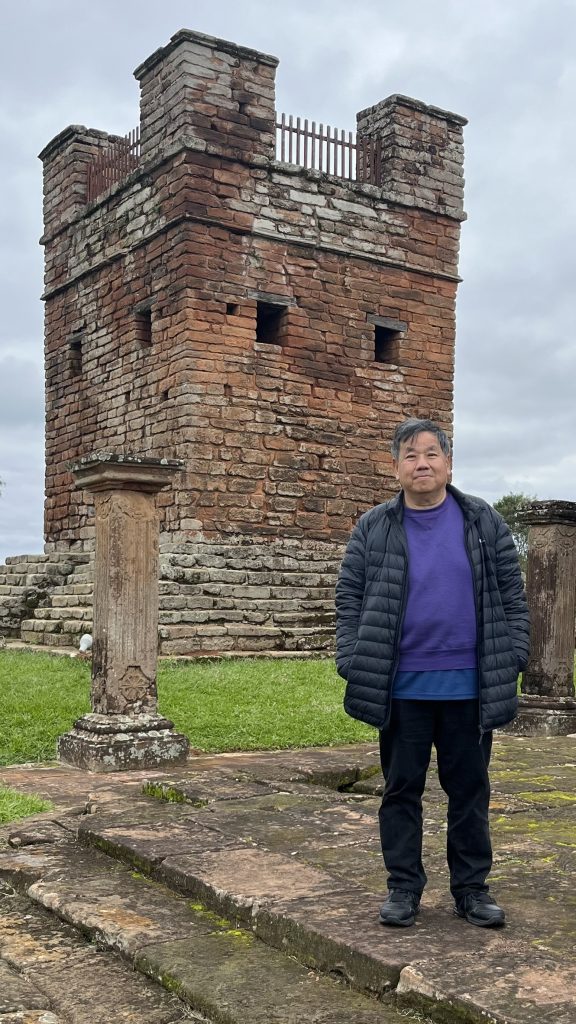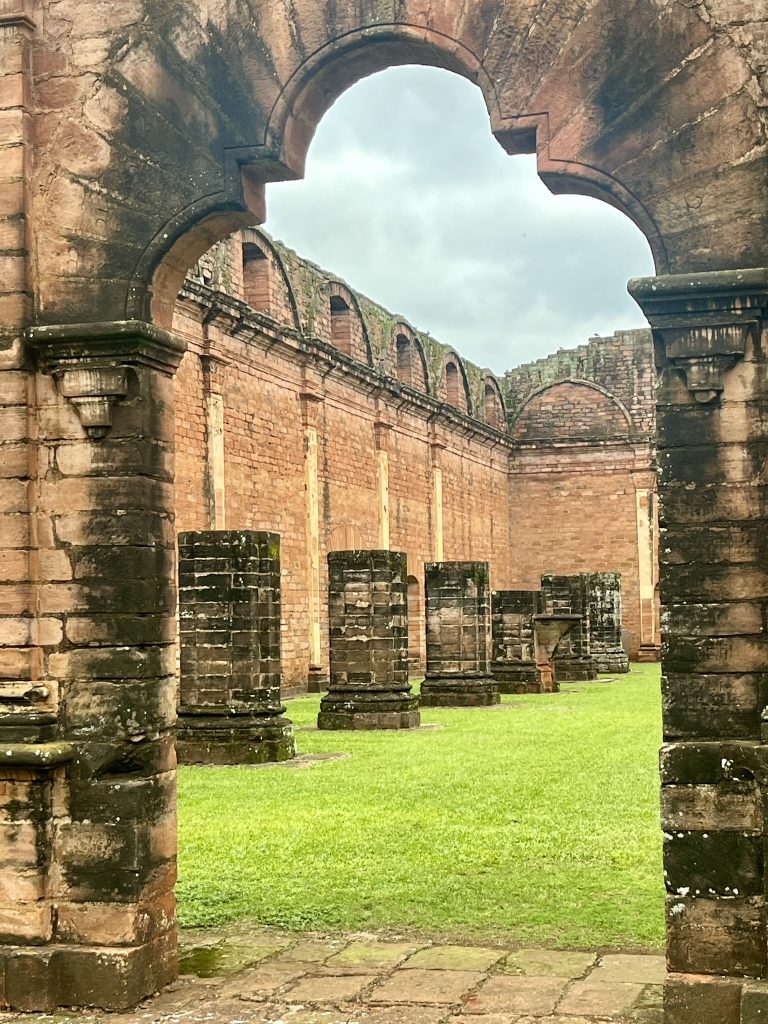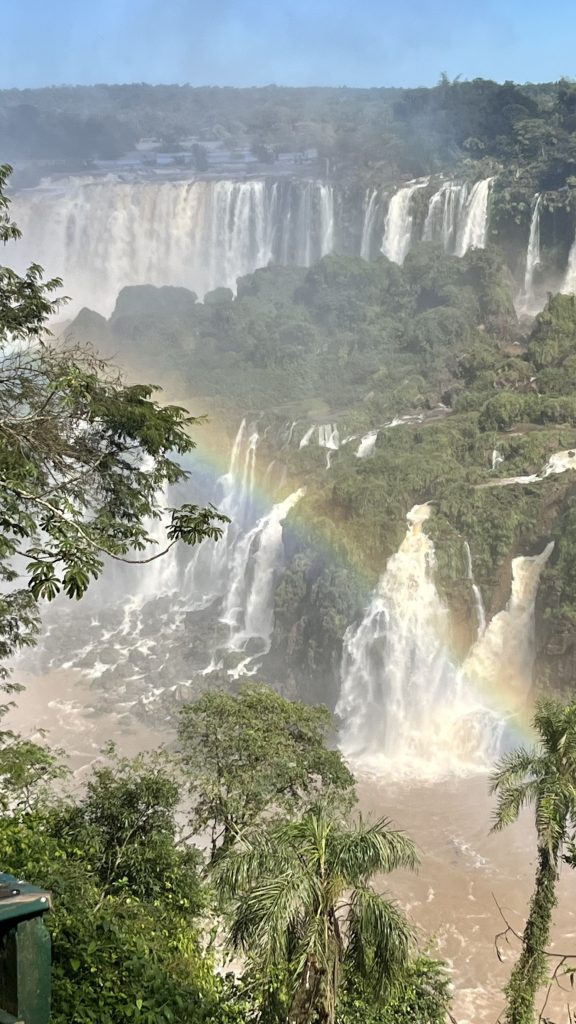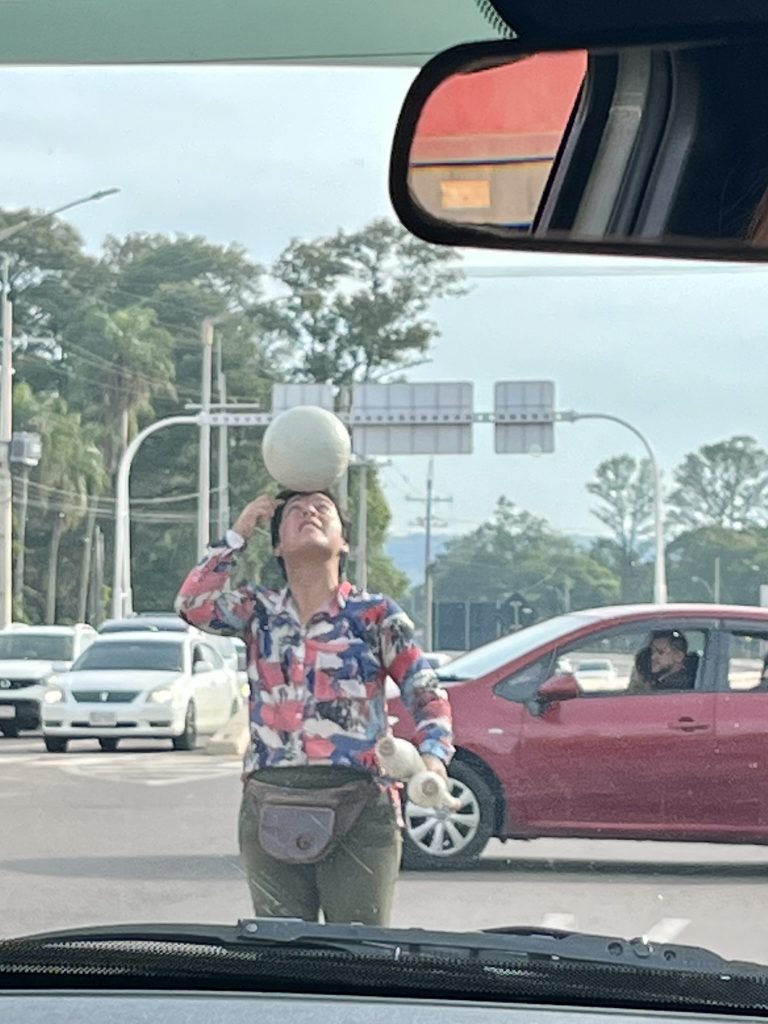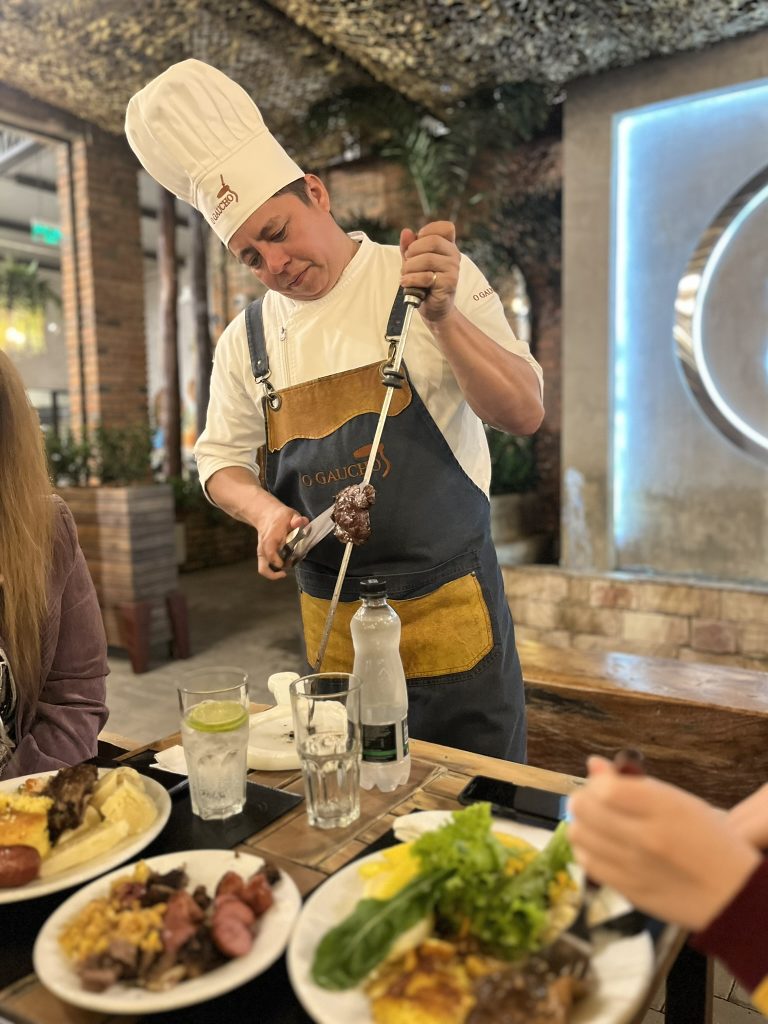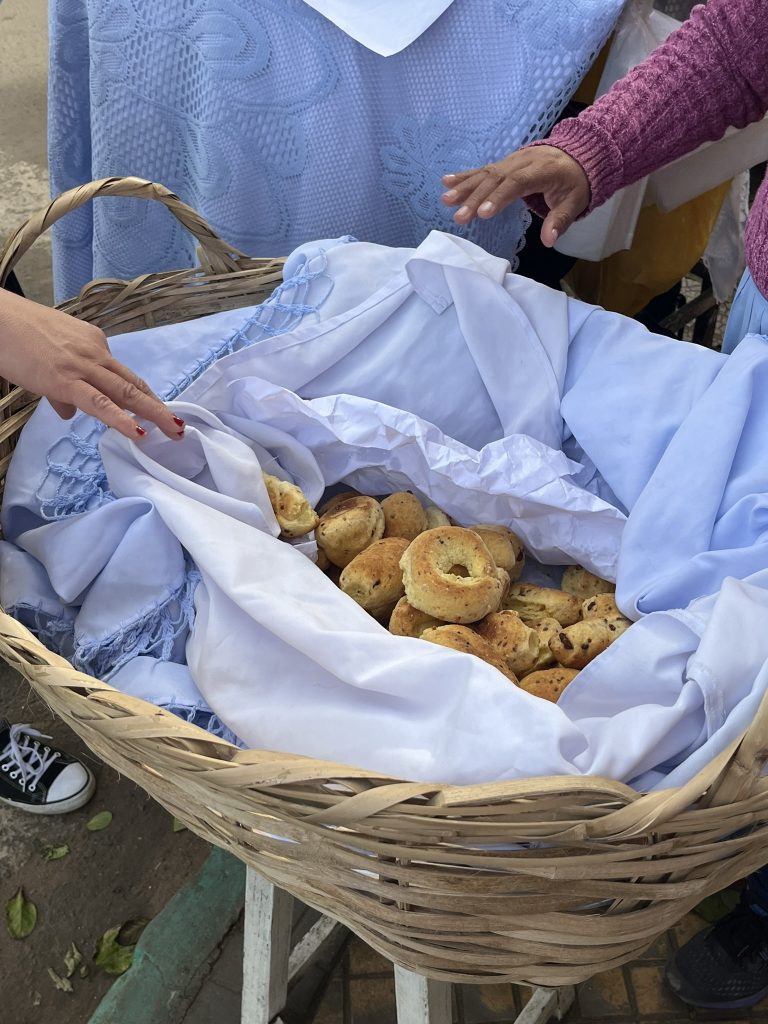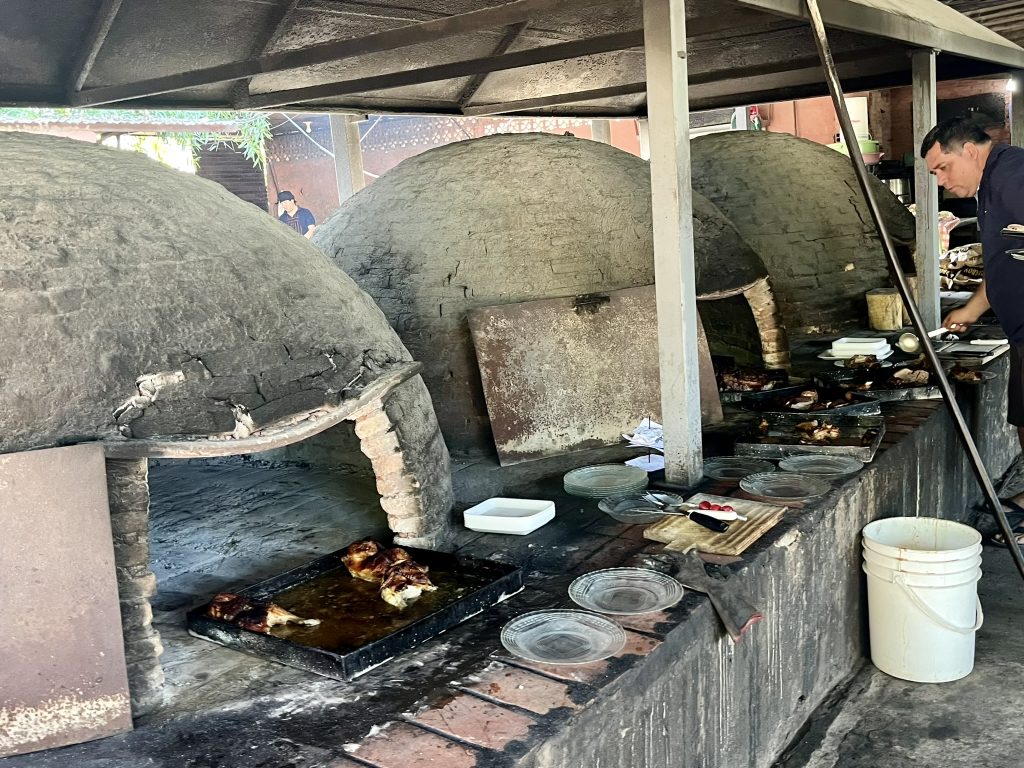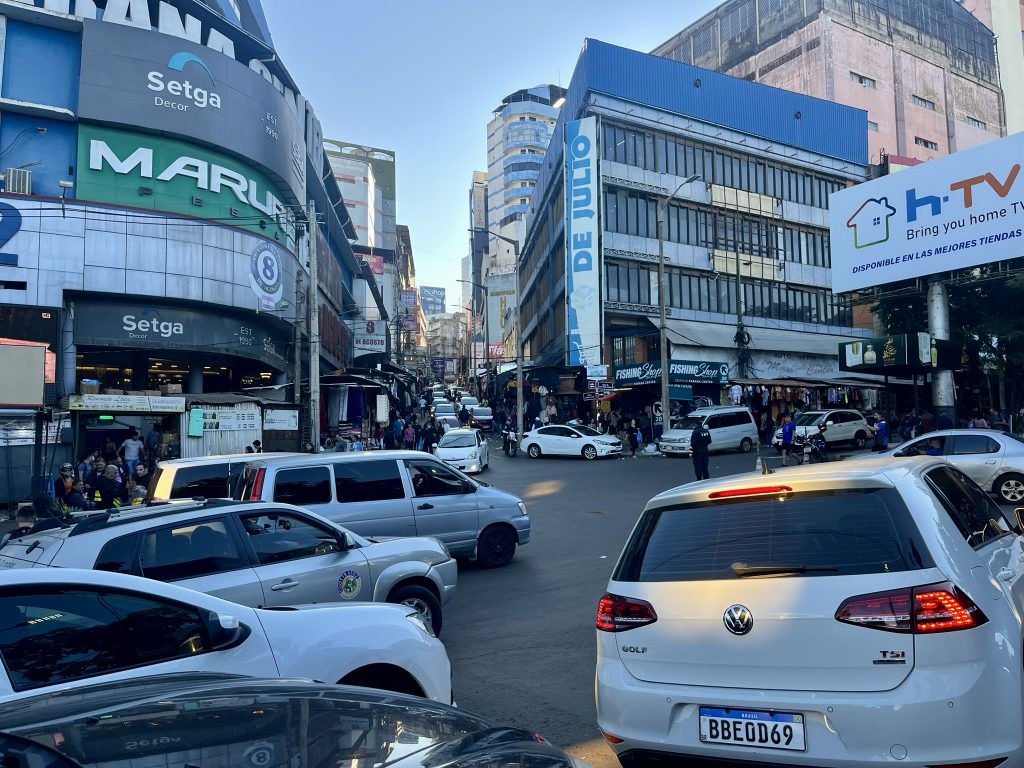For most people, Paraguay is an empty space on the map of Latin America: a country of only 6 million, where a vast percentage of the land is steaming hot jungle or a huge scrub desert known simply as the Chaco. Only a few large cities offer a respite from the oppressive heat.
~ Anthony Bourdain from Parts Unknown
Paraguay is in the middle of South America, and it has always been near the top of my list. Long ago, I read Graham Greene’s (the author, not the actor) novel Travels with My Aunt, and the journey ended in Asunción. It’s a great novel. The movie adaptation, not so much. Then a chapter on Asunción in the brilliant book Falling Off the Map: Some Lonely Places of the World by one of my favorite authors, Pico Iyer, sealed the deal for me. Finally, the comedic film Moon Over Parador, starring Richard Dreyfuss, could be a parody of the country Paraguay. That old movie is good.
San Benardino
Paraguay is a small, landlocked country in the middle of South America. Its official languages are Spanish and Guaraní (an indigenous language). There are several sizable Mennonite colonies in the western part of the country that have maintained their Germanic culture and language. It is one of the few countries that still has diplomatic relations with Taiwan, rather than the People’s Republic of China.
Paraguay is the least visited country in South America, and that is one of the reasons I had never taken the trip until this June. It would have been a bit of a challenge to travel there without any local contacts. Thankfully, a friend who is a former student has been living in Paraguay for almost ten years and invited me to visit. Because of the generosity of him and his family, who provided me with lodging, drove me across the country to visit the Jesuit Missions, and arranged a taxi to take me from the border city of Ciudad del Este to see the majestic Iguazu Falls in Brazil.
My friend and his family live in the resort town of San Bernardino, located on the shores of Ypacaraí Lake. San Bernardino is approximately 50 kilometers (31 miles) from Asunción. June is the beginning of winter in Paraguay, and the town was relatively quiet, but I was told it is a hopping place in the summertime. During the days that I was in San Ber, we went for a couple of hikes, strolled around the lake, visited the Nuestra Señora de la Candelaria church, and had a couple of sumptuous asados (grilled meat feasts).
Jesuit Missions at Trinidad
About 270 km from San Bernardino is the town of Trinidad, where the remains of several Jesuit missions are located. It took us about 4 hours to get there by car. We visited the missions of La Santísima Trinidad de Paraná and Jesús de Tavarangue. These missions were established in the early 17th century and are remarkable remnants of the Jesuit Reductions, where the Jesuits aimed to convert and educate the indigenous Guaraní people. At their height, these missions housed thousands of residents; La Santísima Trinidad alone had a population of around 3,000 people. The site was quiet during our visit, but amidst the architectural grandeur and the meticulously planned layout of these buildings, we could sense that there was once a vibrant community.
However, the missions’ flourishing community was disrupted in 1767 when the Jesuits were expelled from Spanish territories. This expulsion was primarily due to the increasing tension between the Jesuits and the Spanish Crown, which feared the growing power and influence of the Jesuits.
Ciudad del Este
After our visit to the Jesuit Missions, we drove a couple of hours to the bustling border city of Ciudad del Este (East City). The city is connected to Brazil by the Friendship Bridge over the Paraná River. We came here because it is a gateway to Iguazu Falls on the Brazilian side of the river. Ciudad del Este’s former name was “Puerto Presidente Stroessner” in honor of the dictator Alfredo Stroessner. The name change became necessary when Stroessner was overthrown in 1989 in a coup d’état led by General Andrés Rodríguez. (Fun fact: Alfredo Stroessner’s son, Alfredo Stroessner Jr., was married to Ana Rodríguez, Andrés Rodríguez’s daughter.)
Unlike the more laid-back pace of the rest of Paraguay, Ciudad del Este is a whirlwind of activity. The city is renowned for its vibrant shopping scene because of its tax-free status. Drawn by the promise of good deals, many bargain seekers stream over from Brazil. The busy streets are choked with cars, taxis, and vans, and we saw a queue of hundreds of trucks waiting to cross the border into Brazil. During our stay, out of nowhere, a man with a large duffel bag walked by us casually and offered to sell us a taser gun. We declined. We found a hotel that offered clean rooms and decent beds. A room with a simple breakfast cost about Can$35 a night.
Iguazu Falls (Brazil side)
WOW! I repeated that word several times as I stood beneath the Devil’s Throat, listening to the mountain of water thundering behind me.
None of the photos I had seen or literature I had read prepared me for the awesome sight of Iguazu Falls. Although I knew they are higher than Niagara Falls and carry more water than Victoria Falls, being here in person was just awe-inspiring in the true sense of the word.
About an hour earlier and 30 km away from this spot, on the Paraguayan side of the Friendship Bridge, my friend and his partner found a taxi driver who would take me and one of his daughters on this journey. We were driven a few hundred meters to a border post for customs formalities, then crossed the bridge to the Brazilian side, and finally transported to Iguaçu National Park.
The trip to the park was smooth and uneventful, offering me a glimpse of the more developed city of Foz do Iguaçu, Brazil. The fact that we didn’t have to go through immigration when we entered and departed Brazil surprised me, but I think it was a special arrangement between the two countries for tourists on short visits.
Once we arrived at Iguaçu National Park, we bid farewell to the taxi driver, who said he would see us after we visited the falls. We purchased our tickets at the automatic machines and then boarded a shuttle bus that took us to the beginning of a trail. From there, we walked down a gentle path that provided us with breathtaking vistas of the cascading water.
At the end of that trail, beneath the Devil’s Throat, was where I uttered the word ‘WOW’ several times.
Paraguay Eats
I love food, and one of the joys of traveling is sampling the local cuisine. Similar to other South American countries, Paraguayans love their asado. An asado usually consists of beef, pork, chicken, chorizo, and morcilla, all of which are cooked using an open fire or a grill, called a parrilla. Although I was only there for five days, I managed to go to two asado restaurants. One evening, as a small token of thanks for their generous hospitality, I took my friend and his family to Churrasqueira O Gaucho for dinner in San Bernardino. It is akin to Brazilian BBQ in North America. The staff would come around to our table with various kinds of meats on long spits, and they would keep returning until you said no more. In addition, there were copious amounts of bread, salads, cold cuts, cheeses, and desserts. There were five of us, and the bill only came to 850,000 Guarani. I added a tip of 120,000 Guarani, but I should have rounded it up so that I could claim I spent 1 million on a supper (note: Can $1 is about 5,500 Guarani. So 850,000 Guarani is about Can. $150).
The second asado was a farewell lunch at Copetín La Esperanza in San Bernardino. The restaurant was much more informal, and there were eight of us. All the patrons sat in an open courtyard adjacent to three domed-shaped BBQs. At the corner of the courtyard was a stack of plastic tables next to a couple of stacks of plastic chairs. I noticed people would just help themselves by finding a spot and setting up their own tables and chairs. We were offered a variety of meats, but the popular short-ribs were already sold out even though lunch service had just started.
In addition to the delicious steaks, I enjoyed several servings of chipa, a popular snack that resembles bagels, except it is made with cassava flour and cornmeal. The recipe is said to have originated from the Guarani people of Asuncion in the 18th century. They are inexpensive and often sold from street-side stands by vendors carrying a large basket with warm chipa wrapped in a cloth.
Another local food that I partook in was sopa Paraguaya. Despite its name, this is not a soup but a type of cornbread made with cornmeal, cheese, milk, and onions. It’s a staple dish in Paraguayan cuisine.
Additional Photos from Paraguay
Other related materials
- Amateur Traveler Episode 791: Paraguay
- Falling Off the Map: Some Lonely Places of the World by Pico Iyer
- Travels with my Aunt by Graeme Greene
- Moon Over Parador, movie starring Richard Dreyfuss
- Anthony Bourdain Parts Unknown Season 4, Episode 3: Paraguay
- My visit to Buenos Aires, Argentina
- My visit to Uruguay
- An old article (1989) on Vanity Fair on General Strossner

